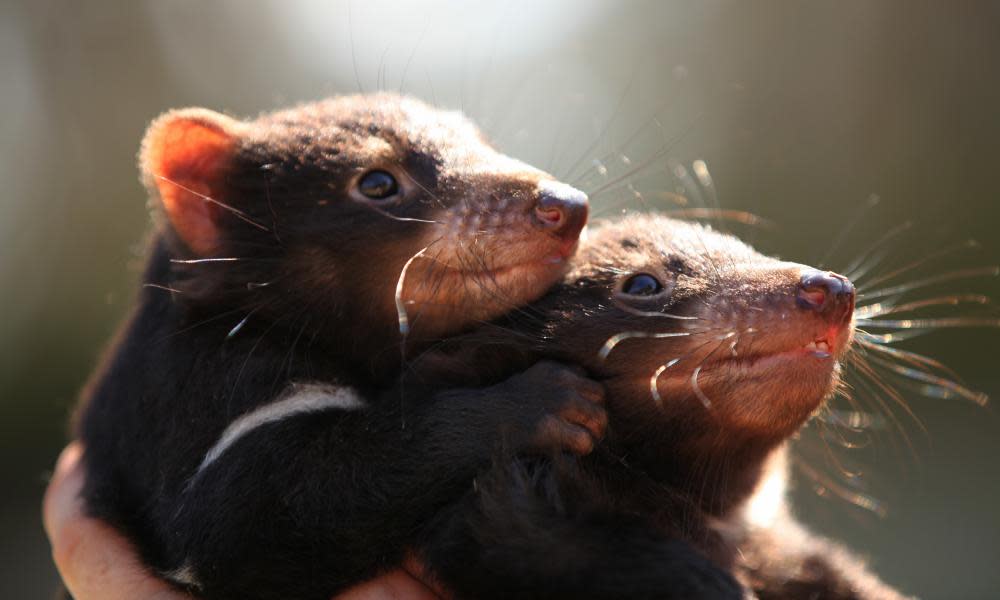Tasmanian devils released into sanctuary north of Sydney in step towards 'rewilding'

Conservationists working with disease-free Tasmanian devils have taken the next step in what they hope will be a “rewilding” project that could eventually see the species reintroduced to the Australian mainland.
About 30 devils, free of devil facial tumour disease, have been released into a 500ha, predator-free sanctuary in the Barrington Tops national park, north of Sydney.
Aussie Ark will use tracking devices and camera traps to monitor how the animals fare in their new environment and consider whether the release of devils into a wild environment could help conservation.
If the devils breed and thrive in the sanctuary, another group of animals will be released into a second predator-free area in a year’s time.
Related: Unesco urged to oppose 'alarming' changes to Australian environment laws
Tim Faulkner, the president of Aussie Ark, said the eventual goal is to release Tasmanian devils into the broader landscape to see whether the reintroduction of a native species that is an apex predator will help restore the ecology of forests that have been devastated by foxes, cats and other invasive predators.
“Once we move and bleed out from sanctuary-type management into natural landscape, the concept is that we have a natural predator roaming the landscape,” he said.
“Tasmanian devils represent a very unique natural control measure for our feral pests and in the absence of mainland predators they bring balance back to the ecosystem.”
Aussie Ark began breeding an insurance population of Tasmanian devils at Barrington Tops a decade ago when devil facial tumour disease caused massive declines in devil populations in Tasmania.
Until now, the devils at Barrington Tops had been held in football field-sized enclosures at an altitude of 1,350 metres, with cool conditions similar to those in Tasmania.
Thirty devils were chosen for the first release into the new sanctuary and will be assessed quarterly to check their health and reproduction rates. Conservationists working on the program will feed the devils initially but that will be tapered off, with the animals expected to predate on kangaroos, wallabies, wombats and possums.
Tasmanian devils used to inhabit mainland Australia. The exact point at which they became extinct on the mainland is uncertain, but scientists have suggested dates ranging from 500 to 5,000 years ago, their extinction being attributed to factors including climate change, hunting and the introduction of the dingo.
What ecological role they might play, and the value of reintroducing a native apex predator to mainland Australia, has been a subject of much debate in the scientific and conservation community.
Euan Ritchie, an ecologist at Deakin University, has researched the ecological role of Australia’s predators and how they might be used in conservation to assist in ecosystem restoration.
He said devils were not just “scavengers” and would also hunt prey, with some research suggesting they may keep overabundant herbivores in check, as well as feral pests.
Related: Inside the rescue of the pilot whales stranded in Tasmania
Ritchie said there were risks attached to the reintroduction of a species to an ecosystem because any new species would interact with and affect other animals and plants to varying degrees.
“Any reintroduction of devils would need to take this into consideration, especially if the reintroduction was to occur beyond a fenced sanctuary, and in the presence of any already threatened potential prey species of devils,” he said.
But Ritchie said Australia’s “atrocious” conservation record, including its world-leading rate of mammal extinction, meant the country needed to consider new approaches to restoring ecosystems and returning devils to some regions was “worth pursuing”.
Menna Jones, an ecologist at the University Tasmania, has spent three decades researching predators and marsupial carnivores, including the Tasmanian devil.
She said in circumstances where the reasons for local extinction of a species were understood and the presence of that species could serve an ecological function, there was “absolutely no reason you couldn’t put it back”.
However, Jones said reintroducing devils would require staged trial releases to gather evidence of their impact on the landscape, including of whether they predate on foxes. She said wide consultation with anyone likely to be affected – particularly farmers – would be essential.
“It’s not a rapid process,” she said.
“We need to be doing this with broad consultation and we need the evidence that putting them back on the mainland won’t create an increased problem, it might solve an existing problem.”

